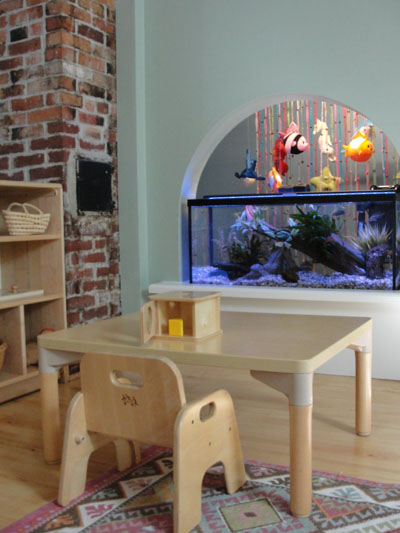Montessori’s Youngest Students: Infants and Toddlers

 Interest is building in our new program for infants ages 6-16 months. The Bambini program for infants is offered for full and part-time enrollment. The classroom is carefully and beautifully designed to allow freedom of movement and respect for the child’s natural rhythms. The educators are nurturing and caring and hold certification as Montessori infant/toddler guides.
Interest is building in our new program for infants ages 6-16 months. The Bambini program for infants is offered for full and part-time enrollment. The classroom is carefully and beautifully designed to allow freedom of movement and respect for the child’s natural rhythms. The educators are nurturing and caring and hold certification as Montessori infant/toddler guides.
For deeper insight into the Montessori infant and toddler environments at Winfield Children’s House, we are sharing from an article in the January 2014 issue of Tomorrow’s Child Magazine, the magazine for Montessori families.
“Montessori’s Youngest Students: Infants and Toddler”
by Terri Sherrill
Dr. Montessori wrote: “If the human personality is one at all stages of its development, we must conceive of a principle of education that has regard for all stages.” Rather than relying on preconceived notions about the early years of life, she brought her medical knowledge of anatomy and neurology to her observations of childhood. She realized that many of the previous assumptions and responses to children were actually in direction conflict with human biology, and when provided environments that were in harmony with the process of development, much of what adults had perceived to be “misbehavior” in children….simply fell away.
Montessori was one of the first to understand that the brain (as well as the body) was still in the process of formation for the first few years after we are born – and that lasting outcomes are highly dependent on our physical encounters and experiences during the period. Through a profound respect for the biological laws of nature and for the unique genetic blueprints, drives and gifts of each individual, Dr. Montessori sought to understand and provide children with their daily requirements for health and well-being.
Applied Science
A parent’s ears will often perk up when children get a little too quiet. They know this means, more often then not, that “the kids must really be getting into something!” Making a study of what children universally “get into,” Dr. Montessori discovered many sensitive periods of brain development (the time when millions of neurons are being ‘programmed’ to perceive the stimulus found in their immediate surroundings, and the cognitive architecture for thought and action is being created). She wrote, “None of these sensitivities occupies the whole period of development…While it lasts, there is an outpouring of energy.”
Instead of thwarting a child’s drives, Dr. Montessori provided appropriate means for their healthy expression. She noted that industrialization had radically altered the childhood experiences that had naturally occurred for millennia; therefore, she worked to synthesize and restore vital experiences replete with physiological benefits and implicit information. Indeed, speaking similarly, Sally Goddard Blythe, Direction of the Institute for Neuro-Physiological Psychology warned in 2011: “One of the greatest threats to modern society comes not from diseases of then past (which medicine and hygiene have largely controlled), but illnesses, learning disorders and social problems, which are a direct consequence of modern living conditions, lifestyle, and ignorance of children’s biological needs.”
In her article, “Assessing Neuromotor Readiness for Learning,” Blythe laments that too many infants, toddlers and young children find themselves in “containers” (swings, infant seats, high chairs, etc.) that limit their ability to move and explore; they find themselves exposed to increasing hours of sedentary screen time; and they fluctuate between being bombarded by noise and a lack of appropriate sensory experiences. Her research suggests these cultural practices fail to support the maturation of the vestibular, limbic, or nervous systems and leave primitive reflexes uninhibited past optimal developmental timetables.
Montessori advocated passionately for children on these very topics, using the language of her day. She connected freedom of movement to learning and overall health. She saw that children loved to challenge themselves and provided opportunities for them to struggle and develop their strength and emotional stamina. She saw that order and proximity helped the child to categorize objects and concepts in ways that supported memory and retrieval. Order also helped the child to successfully predict cause and effect — and to pay attention to details for long periods of time.
Predictable order (of events and objects) provides a structure that allows the child to make choices, to be able to follow procedures and directions — and to relax into the joys of childhood. Yet, she did not stop at observation; rather, she created an entire applied science in response to the needs of human development. Children find that materials and activities in a Montessori environment follow a sequence that proceeds in order of use and cimplexity (much as craftsmen might order their tools), while giving them the freedom to respond to individual talents and interests.
